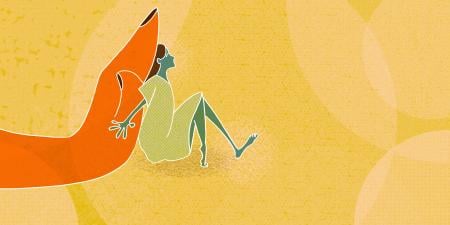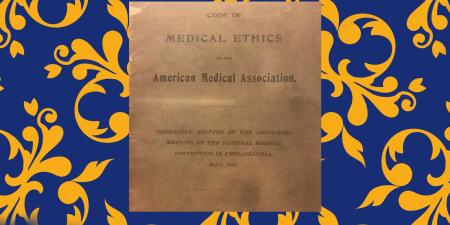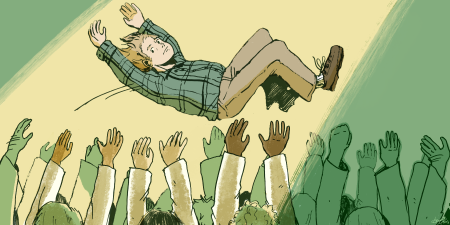Abstract
Through the lens of metaphor and the arts, this article aims to illuminate how persons who are ill tarry through uncertainty to receive care, and, in response, clinicians must resist turfing such patients in a health system that often confers upon patients unclear criteria for belonging. In addition, this article considers relationships among clinicians, patients, and their loved ones through the perspectives of Maris and Ludlow, characters in the book, A Hospital Odyssey, by Gwyneth Lewis. The article suggests that engaged curiosity and empathy are helpful responses to clinical detachment, distraction, and disengagement.
Sometimes all that’s left for a physician
is to make a new tune from the hours of waiting,
to recompose the story in a broader tone, so doctor and patient
can both lose themselves, be found by the muse of time rearranged…
Gwyneth Lewis1
Tarrying in the Realm of Uncertainty
Engaged curiosity and empathy can serve as antidotes to clinical detachment and disengagement from patient care, which can result in turfing responsibility for that care. We explore these dynamics through the perspectives of Maris and Ludlow, characters in Gwyneth Lewis’ fictional narrative, A Hospital Odyssey,1 which describes both encounters with turfing and the invitation for physicians to tarry with patients—to remain engaged with the inherent uncertainty of patients’ care and linger long enough for them to be heard and seen. These experiences of tarrying become an antidote to turfing for both patient and physician.
Turfing and Tarrying
The turfing witnessed in A Hospital Odyssey is not a new phenomenon, and neither are patients’ experiences of uncertainty, suffering, shame, and stigma while seeking care. In Lewis’ description of the hospital, the medical encounter becomes an odyssey, an epic narrative journey depicting how those who are ill tarry through the realm of uncertainty to receive care from a health care system that delineates criteria for sickness. Those who are ill and those who love them arrive in this realm having already lost the previous maps that guide them toward the expected destinations of their lives.2 They arrive in need of sensitivity and compassionate responses to the seismic shift occurring in the world around them. Instead, they find themselves in an increasingly complex and impersonal system that challenges the ability and capacity of those providing care to tarry and resist the impulse to turf, to stay alongside them while they work through their illness experience.
Turfing harms those who are ill by interrupting continuity of care and delaying potential benefits; additionally, it harms health care team members, who experience a range of emotions related to care of the turfed patient that may negatively impact relationship building.3 In one study on alleviating residents’ frustration about caring for turfed patients, residents identified the potential power of empathy as an antidote to turfing: “you can empathize with ’em and help them out as much as possible. And you get something out of that.”4 To receive care and not be turfed, patients must belong to—must fit the criteria of—categories of disease bounded by arbitrary lines, categories that denote illnesses some professionals will tarry with and illnesses some will not tarry with and that often minimize the psychosocial contexts of illness. How categories of disease are delineated and patrolled can mean the difference between a clinician’s ability to stay and linger longer—to tarry—or to turf the patient. In this manner, the “individual doctor or service becomes a territory, and the patient is moved (turfed) from one to another.”4 To tarry with those who are ill and to resist the temptation to turf is to commit, to settle in, to be present with,5 to learn from listening for story—that unique emplotment that is singular6—to attend to the changing nature of illness experiences, and to resist categorizing every symptom experience under a disease label. To heal this tendency toward separation, detached concern, and turfing is to challenge the professional culture of medicine.7 To encourage tarrying offers care and belonging not only for those who are ill but for those who provide care.
While it is the patient who suffers through illness, families also bear intimate witness to the travails of illness and, ultimately, the death of their loved one. They, too, find themselves adrift between 2 worlds as they traverse the kingdom of the ill, reflecting the sentiment that those who are ill and their families experience illness as one unit.8 Maris, Lewis’ protagonist whose husband is critically ill and lost within the hospital’s rhizomic expanse, very early in the text implores the reader to pause and tarry with those who are ill: “Stop reading. If your partner’s near I want you to put this poem down, surprise them at the morning paper…. When they ask, ‘What’s wrong?’ Say, ‘Nothing,’ but hold them close, while you can.”1 Maris thus warns the reader of the challenges ahead.
The Odyssey of Maris
As told through rhyme and metaphor, Maris’ journey begins once she enters the hospital, an unfamiliar territory with its futuristic “infinite corridors” and “sophisticated alien culture.”1 Maris searches in desperation to find her turfed husband through a maze of people only to stumble upon one stiff, guarded doctor, a “Knight Templar” named Ludlow sitting rigidly before her.1 With some interrogation, we learn that Ludlow’s experience embodies that of the burnt-out doctor, one who feels imprisoned by the heavy armor of his role and who “never asks what the hours are for, but suffers them.”1 Ludlow’s station transformed him from someone who was curious, feeling, and engaged to a person exhibiting detached concern, and it is not until Maris pries off his helmet that he can “hear what you’re [Maris is] saying!” Serving as a metaphor for the realities of modern medicine, the caregiver in this scene is weighted with the charge to undo the armor and defenses of doctors, to reacquaint them with their duty, and to encourage them to embrace intimacy and tarrying.9 When Maris painstakingly removes his armor, Ludlow appears with his “alabaster flesh” relit, and beneath the chainmail she finds a “defenseless man,” who exclaims, “I know that person. I think I am ... a doctor! I remember now what I do.... How may I serve you?” In this way, Ludlow demonstrates the reenergizing capacity of connection and curiosity.
To encourage tarrying offers care and belonging not only for those who are ill but for those who provide care.
By following Maris and Ludlow on their journey through a “bureaucratic and technically alienated” medical environment,1 we see examples of how people who are sick can help doctors tarry. The newly reactivated Ludlow starts to engage in Maris’ new disease-defined reality as they travel past territories to which patients have been turfed. With Maris’ lead and example, they navigate the challenge of how to counter unbelonging. One such instance is when Maris finds Phil, an alone and abandoned patient with a malodorous Clostridium difficile infection who, apologizing for his illness and its stench, begs her not to leave. Maris tarries with Phil, remaining at his side despite “gagging ... with waves of decay washing over her,” comforting him and crying tears that “soothed the gore” and closed his wound.1 Through Maris’ encounter with Phil, we see a profound illustration of the intimacy and engaged concern that patients and caregivers can offer to their fellow sufferers, highlighting that there remains a choice for doctors to connect when a patient is turfed and placed before them, however inappropriately. Yet, during this interchange, Ludlow is nowhere to be found; he’s foregone the opportunity to stay engaged with Maris as she interacts with others on her journey. These lost moments to respond to emotional cues and clues reflect missed chances for both empathy and building trust within the medical encounter.10
We reconnect with Ludlow again at the “microbe ball,” exuberantly enjoying the parade of pathogens and host defenses alike.1 A succession of diagnostic possibilities, categorized and then discarded, draw Ludlow along as, with excited curiosity, he follows a “fascinating smudge” and “a trail of phlegm and slime,” intrigued at the potential for new discovery—that is, until they all fall headlong into a web of loss and despair.1 Here, we learn not only that doctors risk being caught up in a maze of medical curiosity and self-interest, but also that family members can become stuck in this ruminative loop while those who are ill suffer the experience of sickness and do the work of healing.11 Ludlow’s folly underscores how, in seeking to reduce and avoid uncertainty within disease categorization, physicians may overlook precious opportunities to tarry with the uncertainties that weigh on patients and their caregivers.
Eventually, as with many great odysseys, we travel to the underworld, to the Island of Uncertainty, where we meet Hippocrates, who counsels Ludlow in the art of uncertainty and to stay attuned for opportunities to tarry with patients when it might simply be “enough to be with your patient.”1 The healer must learn not only to tarry with uncertainty to survive in the territory of the sick, but also to cultivate and express the practice of presence that helps patients flourish. For Hippocrates in the Island of Uncertainty, this education in intimacy comes in the form of the arts, as he hands Ludlow a boxwood flute and instructs him to remember the music when he’s about to perish or reinhabit his former detached and armored existence. The music will heal Ludlow and help create harmony with those he is guided to serve: “others will follow if you find the melodies that heal yourself.”1 Through Ludlow’s reclaimed confidence in his “healership” and, consequently, his clinical leadership, we see him in the final chapter—catalyzed by Maris—riding the “dragon of disease in triumph” at the head of a parade.1 He has come to understand that “[g]ood doctors co-ordinate the body’s rhythms orchestrat[ing] a place to live. For we perform our health, like music, in ensembles, with the limit of our genome…. We can only be as well as our loved ones so, when they fall ill, we suffer.”Thus, having traversed the expanse of the hospital and its many territories of uncertainty where patients are susceptible to being turfed, we arrive at the conclusion that it is in the engaged stillness of intimacy and compassionate empathic care that healing and belonging are possible.
Tarrying as an Antidote to Turfing
Ultimately, the capacity to tarry and resist the impulse to turf resides within the ability of clinicians to journey alongside their patients—those who are ill and their families—through the land of uncertainty. A Hospital Odyssey exhorts us to consider that attending to our patients necessitates settling in, doffing our armor, and exercising our capacity for sustained empathy, compassion, and being present. This commitment can be reenergized through active engagement with those who are ill and, critically, with their family members.8 At its core, a journey that helps to reintegrate existential uncertainty benefits all of us. As Paul Han writes, “Uncertainty enables us to let go of our blinding preconceptions and to simply be silent, open to new possibilities and experiences of meaning.”12 Despite our having established landmarks for tarrying on our journey through the land of uncertainty, there is no denying that policies, mores, and other demands within the present health care system are implicated in the reflexive construction of territories and fiefdoms and of armor and frustration. However, by accompanying Maris and Ludlow, we can find our path forward—nonlinear and uncertain as it may be—whereby intimate engagement and persistence are the first steps in establishing alliance and healing. It is here—through tarrying with turfed patients in the realm of uncertainty—that the opportunity exists to recognize the armor, to remove it, and to closely follow the patient’s lead in composing a new tune of healing in these hours of waiting.
References
-
Lewis G. A Hospital Odyssey. Bloodaxe Books; 2010.
-
Frank AW. The Wounded Storyteller: Body, Illness, and Ethics. 2nd ed. University of Chicago Press; 2013.
- Caldicott CV. Turfing revisited. Virtual Mentor. 2012;14(5):389-395.
- Stern DT, Caldicott CV. Turfing: patients in the balance. J Gen Intern Med. 1999;14(4):243-248.
- Kleinman A. The art of medicine: presence. Lancet. 2017;389(10088):2466-2467.
-
Charon R. Narrative Medicine: Honoring the Stories of Illness. Oxford University Press; 2006.
- Shanafelt TD, Schein E, Minor LB, Trockel M, Schein P, Kirch D. Healing the professional culture of medicine. Mayo Clin Proc. 2019;94(8):1556-1566.
-
Kleinman A. The Soul of Care: The Moral Education of a Husband and Doctor. Viking; 2019.
- Frankel RM, Beckman H. “Won’t you be my doctor?”: four keys to a satisfying relationship in an increasingly virtual world. J Patient Exp. 2020;7(6):851-855.
- Levinson W, Gorawara-Bhat R, Lamb J. A study of patient clues and physician responses in primary care and surgical settings. JAMA. 2000;284(8):1021-1027.
- Cassel EJ. The nature of suffering and the goals of medicine. N Engl J Med. 1982;306(11):639-645.
- Han PKJ. The need for uncertainty: a case for prognostic silence. Perspect Biol Med. 2016;59(4):567-575.



